How Two No-Till Farms Cultivate Soil Health
By Holli Cederholm
Farmers Yoko Takemura and Alex Carpenter of Assawaga Farm in Putnam, Connecticut, have built their entire farm system with the goal of minimizing soil disturbance. “When we pull root crops, those are coming out of the soil,” said Carpenter. “That’s probably the most destructive act.”
Aside from lifting up carrots, turnips and radishes to bunch for their weekly farmers’ market customers in Boston and the farmstand shoppers who select from Japanese vegetables and herbs displayed in their barn, Takemura and Carpenter don’t pull up any other plants on the farm. Instead, they harvest crops like cabbage and kohlrabi by cutting them at the soil line. The roots are left behind as organic matter to decompose and feed the soil.
This is just one of the soil-centric practices of their no-till farming system, now entering its fifth season. “We’ve been no-till from the start, so we don’t know any other way,” Takemura told participants tuning in to the no-till production session at MOFGA’s 2021 Farmer to Farmer Conference, which was held over Zoom last November.
While annually tilling their single acre in production is clearly off limits, they also don’t walk on their crop beds or use hand tools that disturb the soil. They don’t even own a hoe, said Carpenter. Instead, their tool shed is home to rakes and a broadfork for bed prep, a Jang seeder, and a Grillo walk-behind tractor, which they utilize for flail mowing field edges and the occasional cover crop.
Carpenter warned that it’s easy to get dogmatic about no-till, and that what works for them may not work for every farm and every farmer. “It’s more about reframing how you view the soil and the biology in the soil, and then utilizing that as a way to make decisions on the farm,” he said. “The first thing we think about is how is this going to impact our soil biology and then that informs everything going forward.”
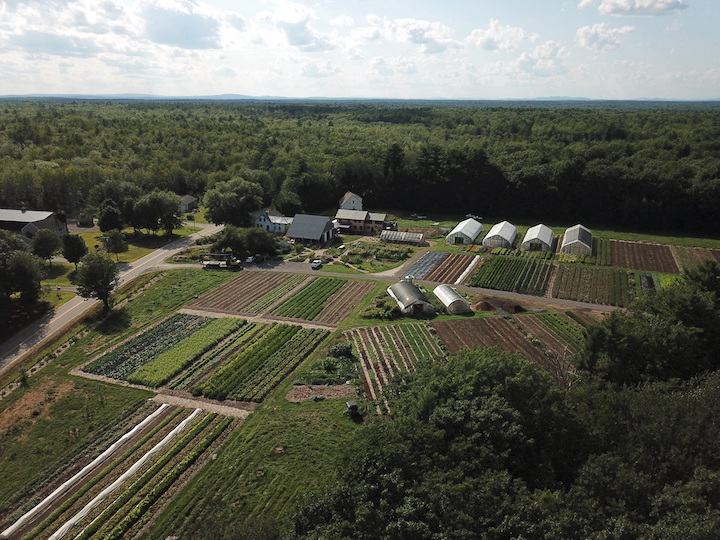
In considering what leads to soil health, another farmer presenting at the Farmer to Farmer Conference, Daniel Mays of Frith Farm in Scarborough, Maine, said that nature laid the foundational principles of no-till. In addition to minimizing disturbance, both aboveground and below, Mays works to maximize photosynthesis, diversity and soil coverage.
Frith Farm, now entering its twelfth season, produces 3 acres of no-till vegetables, flowers and herbs for a 250-member Community Supported Agriculture (CSA) program as well as natural food stores, farmers’ markets and an on-farm store. The farm has 16 plots with 12 permanent 100-foot beds per plot.
Mays did till his soil — just once — using a rotary plow on a BCS walk-behind tractor to open up the old hayfield he was converting to a diversified farm. “It’s pretty aggressive tillage, but it does allow us to break up the sod really well and enable us to form raised beds, ” he said. When tilling, he incorporated compost and amendments, such as lime to adjust the soil pH, based on soil test results. Mays then covered the beds with tarps, using cinder blocks to anchor them in place, to smother perennial weeds that would otherwise outcompete annual crops. Four to six weeks in summer “might be enough to cook out the quackgrass,” said Mays.
Takemura and Carpenter also grow vegetables in 100-foot permanent beds. They purchased the property now known as Assawaga Farm in 2016 and spent two years prepping the land before their first market season in 2018. Similar to Frith Farm, this included breaking ground with a walk-behind rotary plow before laying silage tarps across the production field that is now divided into 100 beds.
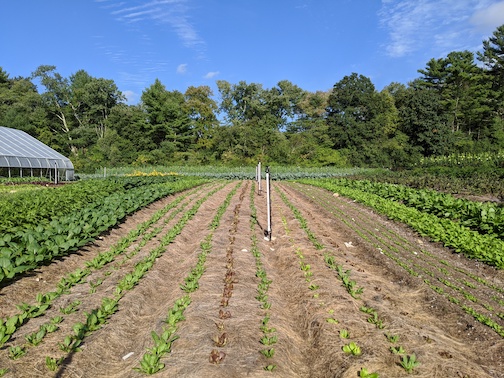
Assawaga Farm pointed out that the tarps on their fields, as well as landscape fabric on the pathways between beds, protected their farm’s fine sandy loam from the elements during their first few growing seasons. A key practice in no-till systems, covering the soil helps to retain moisture during dry periods, like in 2020’s drought, and to reduce soil compaction and erosion caused by rainfall. Due to relatively low upfront costs and labor inputs, Takemura and Carpenter said tarping is a great way to get started with no-till growing. But it creates a “biological dead zone,” according to Carpenter.
Mays would agree. On both farms, living plants take priority as soil covers. “The sun’s energy being pumped into the ground is the engine that drives all of the biology there,” said Mays. Both farms strategically use cover cropping and interplanting to amplify the amount of living plants in the ground throughout the growing season — thereby increasing photosynthesis while also sowing diversity.
You can assess the amount of photosynthesis on a farm at any point in the year with a satellite image from above, said Mays. “How much green do you see versus brown?” he asked.
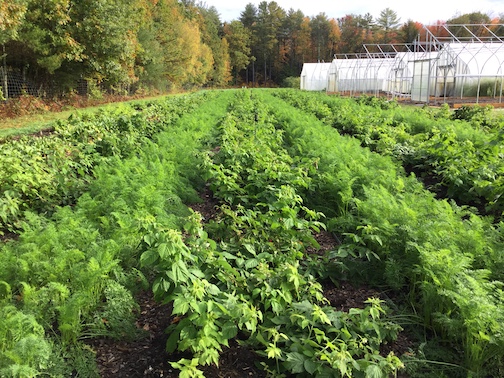
An aerial drone photo of Frith Farm shows a verdant patchwork of plant life. As do the crop photos he shared. In one, two lines of trellised tomatoes in his greenhouse were separated by a plush carpet of basil. Other tomato crops were interplanted with celery or carrots or sweet alyssum, which Mays calls a “great undersowing beneficial plant” due to its shallow root system that doesn’t compete for nutrients and water. Mays packs in plants wherever he can — that includes bok choy on the shoulders of trellised cucumber beds, spinach bordering peas, radishes alongside rows of onions, and carrots next to ginger or first-year raspberry canes or young peach trees. Another favorite pairing on the farm is fungi-friendly clover sown underneath kale, which doesn’t support mycorrhizal networks in itself.
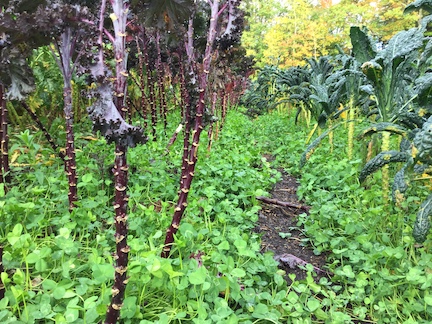
At Assawaga Farm, Takemura and Carpenter also sow crimson clover as an understory beneath long-season cash crops, sprinkling the seeds along the edges of their beds once the plants are established. This is one of the only instances in which the duo seeds a single-species cover crop. Carpenter said they prefer a “broad-spectrum array” and have been known to stack 10-plus species in a mix. Each species adds different exudates into the soil and bolsters the soil microbes in a different way, he said.
Mays and members of his seasonal crew of nine utilize EarthWay push seeders to sow cover crops — typically peas and oats or rye and crimson clover, depending on when the beds need to be “flipped” to a marketable crop. “I think we walk about 3 miles per plot to seed all that,” said Mays. He’s pleased with the germination rate though, and the EarthWay’s drag chain covers the seeds to the dismay of hungry crows. The cover crops are weeded and watered — with overhead irrigation — like any other crop on the farm.
Takemura and Carpenter broadcast their cover crops — grabbing fistfuls of a diverse mix, such as buckwheat, pea, sorghum sudangrass and Brassica seeds, and scattering them across the temporarily bare earth — before gently raking the bed smooth and mulching it with hay.
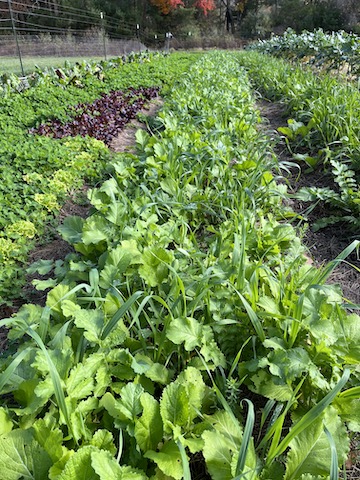
The hay is a critical piece of Assawaga’s no-till puzzle. In late 2020 Takemura and Carpenter blanketed all of their beds with hay mulch, spreading it by hand with the help of one part-time employee. “Mulch is definitely not cheap and it’s not cheap to apply it,” said Takemura.
However, it’s worth the extra expense and labor outlay in that the hay mulch provides optimal soil coverage while cover crops or transplants are getting established and again post-harvest when foliage that was protecting the soil has been removed. As an organic material, hay also breaks down during the season, enriching the soil. (The “ongoing maintenance” will be significantly less than the initial spread, said Takemura and Carpenter.)
Mays echoes that it is not worth skimping due to cost when it comes to covering the soil. “Like Alex and Yoko, at a bare minimum, we have a layer of mulch on the beds at all times,” he said. At Frith Farm, this means either a 3-inch coating of compost or, now that their beds are rich in nutrients from a decade’s worth of annual applications, a less-nutrient-rich bark mulch. Wood chips are spread in the pathways. He described soil as “the internal organs of the Earth,” adding that “they don’t want to be hanging out in the air exposed to the elements.”
The judicious use of mulches at Frith Farm, coupled with their tarping techniques and an ethos to never let a weed set seed, keeps weed pressure extremely low. Pictures of Assawaga’s fields also show tidy rows of produce with nary a weed in sight.
However, the time the farmers save on weeding might be spent on preparing a bed for the next crop. While other growers might plow under or till in crop residue, at Assawaga a bed of, say, kale or peppers is terminated by lopping off plant growth at ground level and carrying off the aboveground plant matter to incorporate into a compost pile. For arugula and spring-sown cover crops, Takemura and Carpenter drag a clear plastic tarp over spent beds on a hot and sunny day, leaving it to solarize for less than 24 hours. For stubborn winter rye, they employ an opaque tarp in a similar fashion.
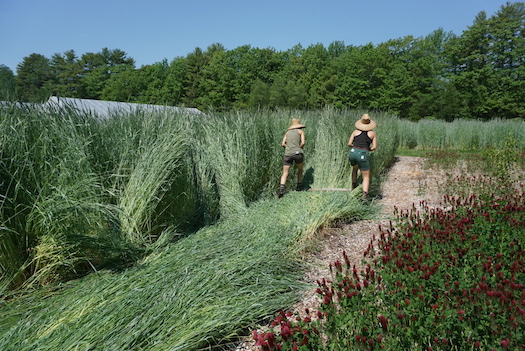
Mays finds that solarization doesn’t work well in his more northerly climate. Crops under a clear tarp during a summer stretch of cool and cloudy 70-degree weather may thrive instead of die back. He sticks to black traps for terminating crops, like kale or arugula, that leave a lot of plant matter post-harvest. He also tarps knocked-down cover crops of oats or rye, which both form a straw mulch on the beds after two to ten days in darkness.
Mays estimates it takes his crew twice as long to transplant into winter rye residue as it would bare soil. “There’s a huge amount of root mass to work through,” said Mays. Other transitions are much more seamless. For instance, carrots can follow head lettuce with little more work than raking out a smooth seed bed.
Takemura and Carpenter have to rake their hay mulch aside after a crop is terminated. They then broadfork the bed to create vertical channels for air and water in the soil. Next, they apply their on-farm-made compost at a rate of one 5-gallon bucket per 50-foot section of bed. “We treat it as an inoculating compost,” said Takemura. Fertilizer is also added if needed. What happens next depends on the crop plan. If they’re transplanting into the freshly prepared bed, they’ll then crawl alongside it, replacing the hay. If sowing a fine-seeded cash crop, like hakurei turnips, the hay is completely removed from the field. After applying fertilizer, they push their Jang seeder down the bed and then unspool floating row cover to provide a degree of protection to the exposed soil while the plants are setting the top growth that will shield it.
Assawaga’s transition to hay mulch presented additional challenges. In 2021, their soils were slower to warm in spring, and the mulch created a habitat for pests. “It was kind of like a slug apocalypse,” said Takemura.
Carpenter added that the crop damage was minimal despite the high population. Takemura quipped, “Except for bok choy. They love bok choy.” They credit the arrival of these garden gastropods (as well as increased vole pressure) on the farm to a drastically changed ecosystem. In other words, adding hay was a disturbance. The two expect the uptick in pest pressure to level out in coming years. To help attract natural predators, they’re planning to incorporate hedgerows into their production zone.
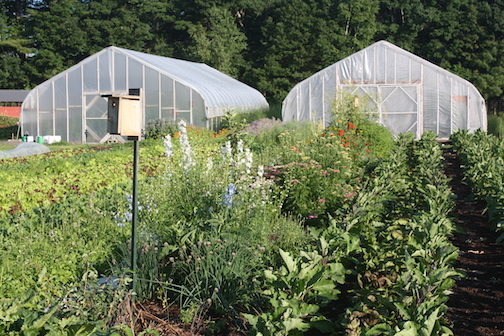
In addition to providing habitat for natural predators and beneficial insects, perennial plantings increase diversity — one of the key ingredients in the no-till approach to agriculture. The variety of living roots in the soil year round act as “a continual I.V. drip of exudates for microbes underground” so that diversity expands and multiplies in ways that it can’t with annuals alone, said Mays.
Each plot at Frith Farm is bordered by a perennial hedge planted with a range of species selected to create continuous overlapping bloom periods, from early spring through late fall. Shorter woody shrubs, such as chokeberry, blueberry and summersweet — and even some dwarf fruit tree cultivars — mingle with herbaceous perennials, like crocus, yarrow, nodding onion, echinacea and boneset. Native bunch grasses (big and little bluestem) provide overwintering habitat for insects, and thoughtfully placed birdboxes fill with eastern bluebirds in the spring.
The hedgerows also provide economic diversity to the farm in the way of saleable berries, fruits, medicinal herbs, and flowers. Mays said that they add beauty and create a nice place to work — and you can’t really measure the value of that.
“The goal is to attract a diversity of life, and humans are included in that,” said Mays. “They say that the best fertilizer is a farmer’s footsteps.”
A recording of the no-till production session at the 2021 Farmer to Farmer Conference is archived on MOFGA’s YouTube channel.
